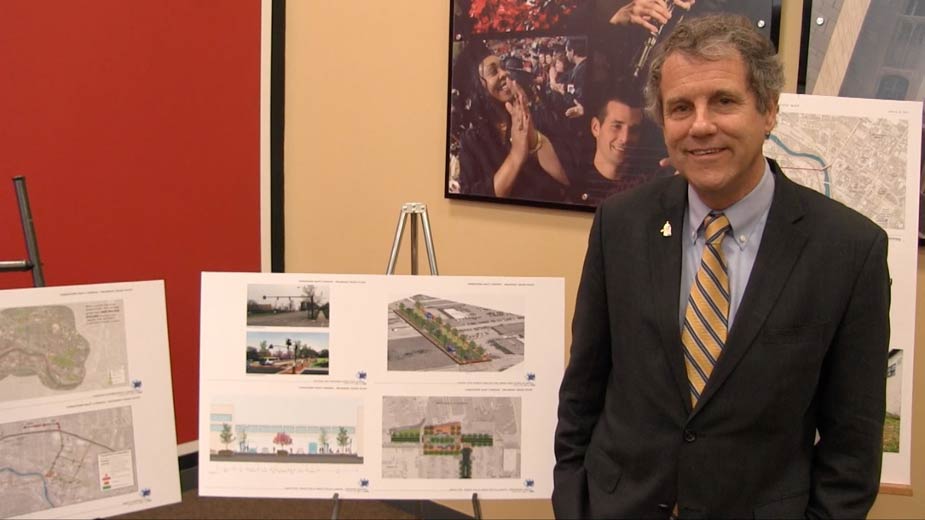Partners Want to Be Prepared for Infrastructure Spending
YOUNGSTOWN, Ohio – Proponents of a proposed $15.5 million infrastructure plan for the downtown area are eager for President Donald Trump to follow through on his pledge to spend $1 trillion on the nation’s infrastructure.
U.S. Sen. Sherrod Brown, D-Ohio, joined local partners in the local SMAR2T Corridor project at the Covelli Centre Friday morning to tout a roadmap he and other Senate Democrats drafted in response to Trump’s infrastructure pledge.
The proposal outlined earlier this week includes $10 billion in funding for the Transportation Investment Generating Economic Recovery – or Tiger – grant program administered by the U.S. Department of Transportation.
An application submitted by local partners including the city of Youngstown, Mercy Health Youngstown, Youngstown State University and Eastern Gateway Community College for $15.5 million in Tiger grant funding was passed over last year.
If approved, the grant would connect major employers like Mercy Health and YSU, improve streets and pay for other infrastructure upgrades.
The Youngstown SMAR2T — Strategic Medical Academic Residential Recreational Technology Corridor – project “enhances our entire downtown area,” Mayor John McNally said.
“What we wanted to do was look at the strategic enhancement of connecting the medical campuses to the academic campuses at YSU and down to Eastern Gateway,” he continued. The project also considered enhancing connections for residents of downtown and “increasing transportation opportunities for everybody in this corridor,” he continued.
“This is how you spur development sites for growth. This is what it’s all about,’ said Jim Kinnick, Director of Eastgate Regional Council of Governments. “Infrastructure is the pipeline to economic development and we can’t let that fail.”
The application was not funded — it was among 240 projects that made it to the transportation secretary’s desk that were “highly rated” – but because of lack of funding at the federal level, Brown said.
“This is an outstanding application,” Kinnick said.
From 1945 to the early 1980s, America had “the best infrastructure that the world had ever seen,” but since then government’s view of infrastructure investment has changed, he said.
“We inherited the greatest infrastructure the world had ever seen and we haven’t even maintained it,” Kinnick continued. Infrastructure spending not only provides good jobs in construction and industries that supply materials for projects but also “sets the table for so much else in the Mahoning Valley and around the country.”
Brown acknowledged that Senate Republican leadership isn’t enthusiastic about infrastructure spending but it is a priority for Trump. The Senate Democrats put forth their plan to start with a “good faith effort” heading into further discussion, he said.
Mercy Health’s support for the project is based on it addressing two top priorities, Don Koenig, executive vice president and chief operating officer, said. He also serves as president of St. Elizabeth Youngstown Hospital, “our flagship facility.”
One priority is developing the next generation of health-care providers, which the project would assist by improving access for students traveling from YSU and Eastern Gateway to St. Elizabeth, where many of them do clinical rotations , as well as for employees who are furthering their education at one of the institutions, Koenig said.
The other is enhancing patient access “for many of our lowest income residents of the community, for whom transportation is often a barrier to accessing better, high-quality health care,” he continued.
A look around the YSU campus – particularly the recent Lincoln Avenue upgrade – offers a vision of “the first vestige” of what the improvements offer, said Mike Hripko, YSU associate vice president for research.
“The community now enjoys expanded sidewalks, enhanced lighting and clearly designated crosswalks,” he said. Such improvements make a difference to prospective students and faculty, and the government and industry leaders who visit the campus to get a “first impression not only of YSU but of Youngstown and the Mahoning Valley,” he said.
The increased pedestrian traffic and slower vehicular traffic brings vitality to the neighborhood. “You can see the energy is affecting the businesses along Lincoln Avenue,” he said.
Despite being passed over for the Tiger grant, the local partners have continued to pursue elements of the corridor plan, including by ‘being aggressive’ in seeking money for a proposed bike trail that would connect to Mill Creek Park, Kinnick said.
The city also is working on addressing various downtown streets, including Fifth Avenue. By moving forward with components, the partners want to be well positioned for the next opportunity for a Tiger grant, McNally said.
Pictured: U.S. Sen. Sherrod Brown stands in front of renderings of the SMAR2T Corridor infrastructure project proposed for downtown.
Copyright 2024 The Business Journal, Youngstown, Ohio.



